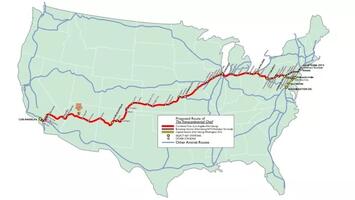
According to Newsweek, some nutty group called AmeriStarRail is proposing to run high-speed trains from New York to Los Angles, which it says can be done at a profit. Only they wouldn’t be high-speed trains and they almost certainly wouldn’t earn a profit.
The AmeriStarRail proposal is to run a train from New York to Los Angeles on existing tracks. The train would take 72 hours for an average speed of 45 miles per hour, which is hardly a high speed. The train would replace, not supplement, existing trains on the proposed route: the New York-Pittsburgh Pennsylvanian, the Pittsburgh-Chicago portion of the Floridian, and the Chicago-Los Angeles Southwest Chief.
I’m not sure why they didn’t choose the more obvious route, the Lake Shore Limited and Southwest Chief, which currently takes only 67 hours to get from New York to Chicago. Replacing the Floridian with this transcontinental train would leave that train, which continues from Pittsburgh to Washington and then to Miami, dangling. That’s not much of a loss as I doubt many people take it from Chicago to Miami anyway.
The twist that would supposedly make this profitable is that AmeriStarRail is proposing to carry trucks (and their drivers) as well as passengers, thus putting Amtrak in the freight business in competition with the railroads that would host the train. There aren’t enough trucks going between New York and Chicago to make this profitable, so the freight railroads probably wouldn’t care.
According to its web pages, AmeriStarRail consists of a “team” of four people: a bankruptcy attorney (which is appropriate), a former president of Amtrak, and two former transit agency employees. Somehow I don’t think that three people experienced in running money-losing organizations are going to come up with realistic proposals, but at least they’ll have the help of a bankruptcy specialist when the proposals fail.
Read the rest of this piece at The Antiplanner.
Randal O'Toole, the Antiplanner, is a policy analyst with nearly 50 years of experience reviewing transportation and land-use plans and the author of The Best-Laid Plans: How Government Planning Harms Your Quality of Life, Your Pocketbook, and Your Future.
Photo: Courtesy the Antiplanner.












